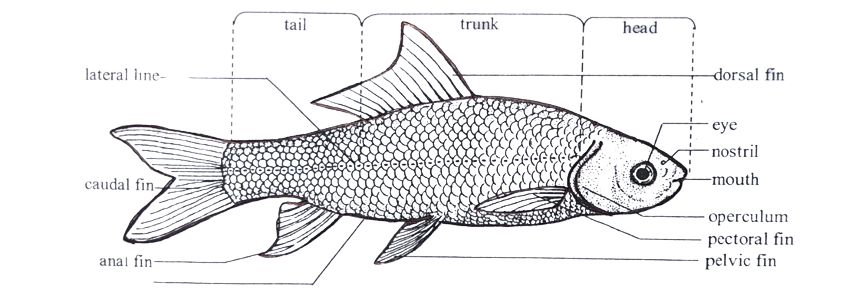In this article, we will learn about the external morphology of Labeo rohita or rohu fish. Labeo rohita is a very common fish in South Asia, especially in India, Bangladesh, and Myanmar. It is a carp fish and it has so much demand in the local market because of its taste. The common name of Labeo rohita is Rohu / Rui. The term external morphology of Rohu, the external structure of Rohu or the external features of Rohu are similar.
Systematic Position / Classification
| Kingdom: | Animalia |
| Phylum: | Chordata |
| Class: | Actinopterygii |
| Order: | Cypriniformes |
| Family: | Cyprinidae |
| Subfamily: | Labeoninae |
| Genus: | Labeo |
| Species: |
Labeo rohita
|
Habit and Habitat of Labeo rohita
- Rohu is an herbivorous fish species.
- Its chief food is various phytoplankton, zooplankton, and aquatic plants.
- It is a fast-growing fish species that can attain a maximum length of up to 1.5 meters and a weight of up to 25 kg.
- Rohu is a diurnal fish species that is active during the day and rests at night.
- Rohu is a bottom-dwelling fish species that is typically found in freshwater habitats with slow to moderate water flow.
- It prefers deep pools and runs of rivers, and can also be found in lakes, ponds, and reservoirs.
- Rohu is tolerant to a wide range of water conditions, including temperatures ranging from 25°C to 32°C, pH ranging from 6.5 to 8.5, and dissolved oxygen levels ranging from 3 to 6 ppm.
Labeo rohita (Rohu) Labeled Diagram

Fig: External morphology of Rohu/Rui
External Morphology of Labeo rohita (Rohu)
1. Shape, Size, and Color
-
-
- Spindle-shaped body.
- The color is greyish or blackish on the back, and silvery-white or pale on the two sides and belly.
- Full-grown individual measures 1 meter in length.
- A full-grown individual measures 20 – 25 kg in weight.
- The body is divided into a head, trunk, and tail.
-
2. Head
-
-
- The Head extends from the tip of the snout to the hind edge of the operculum.
- The snout is depressed, short, and obtuse.
- A pair of external nostrils are present on the dorsal surface of the snout.
- The mouth is subterminal; it is the large transverse aperture, bounded by thick and fleshy lips.
- Two small, thread-like, sensory maxillary barbels are present at the corners of the mouth. Rostral barbels are absent.
- Teeth and tongue are lacking.
- The eyes are large and located on each lateral side of the head.
- The eyes on the head are without eyelids but are protected by a transparent protective membrane.
- Behind the eye, on either side, there is a large movable bony gill cover or operculum present.
- The branchiostegal membrane is attached to each operculum posteriorly.
- Beneath each operculum, there are four comb-like gills in a branchial/gill chamber.
-
3. Trunk
-
-
- It is the thick middle part of the body.
- The trunk is elongated and oval in cross-section.
- It is wide in the middle and narrow towards the dorsal and ventral sides.
- It is covered over by thin, overlapping cycloid scales.
- On either side of the trunk extending from the back of the operculum up to the tail, there is a dark line on the mid-ventral portion of the body called, the lateral line.
- Fins are well-developed and supported by bony fin rays.
- In the trunk region, there found three kinds of fins e.g. dorsal fins, pectoral fins, and pelvic fins.
- On the back of the middle of the trunk, there is a single large somewhat rhomboidal fin called the dorsal fin.
- Just behind the operculum, there is a pair of fins on either side of the body called the pectoral fins.
- Behind the pectoral fins, on the ventral side of the trunk, there is a pair of fins on either side called pelvic fins.
- Three kinds of apertures are found in the trunk region. They are found mid-ventrally at the posterior end of the trunk. The anterior aperture is the anus, the middle is the genital, and the posterior is the urinary aperture.
-
4. Tail
-
-
- It comprises about one-third posterior part of the body.
- It is laterally compressed and narrower behind.
- At the end of the tail, there is a large caudal fin.
- On the ventral side of the tail region, there is a median anal fin lying just posterior to the urinary aperture.
- The tail is the principal locomotor organ.
-
Frequently Asked Questions (FAQs)
1. Do teeth and tongue present in Labeo rohita?
Ans: No, teeth and tongue are lacking in Labeo rohita.
2. Do eyelids present in the eyes of Labeo rohita?
Ans: No. The eyes on the head are without eyelids but are protected by a transparent protective membrane.
—————-THE END—————–
Learn more:
- Digestive System of Labeo rohita | Rohu | Diagram
- Urinogenital System of Labeo rohita | Rohu | Diagram
- Respiratory System of Labeo rohita with Diagram | Rohu
- Labeo rohita – Rohu / Rui
- General Characters of All Classes of Vertebrates.
Reference:

Md Ekarm Hossain Bhuiyan is a dedicated zoology graduate with a profound passion for the study of animal life. He completed his primary and secondary education at Ispahani Public School and College, renowned for its commitment to academic excellence. He then pursued his secondary education at Government Science College. After that he achieved graduation at Department of Zoology, Jagannath University. His educational background and enthusiasm for zoology position him to make meaningful contributions to the field of biological sciences in Bangladesh.